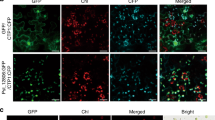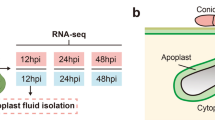Abstract
The fate of ribulose-1,5-bisphosphate carboxylase/oxygenase (Rubisco) was examined in leaves of both resistant and susceptible plants from a Pisum sativum × Pisum fulvum cross after challenge with Erysiphe pisi. High performance liquid chromatography and 1-dimensional gel electrophoresis revealed a 51 kDa protein that was much more abundant in leaves of resistant versus susceptible plants, and which was identified as the Rubisco large chain precursor by mass spectrometry. Greater quantities of Rubisco in resistant tissue suggested that the protein may serve as an important nutrient source for E. pisi in infected susceptible leaves. Liquid chromatography — tandem mass spectrometry revealed three defense-response proteins only in extracts from resistant tissue, while proteins similar to the antimicrobial peptides viscotoxin and phoratoxin from mistletoes, and bubble protein from the yeast Williopsis mrakii, were found only in susceptible tissue. Greater numbers of DNA synthesis and regulation proteins were also identified in the susceptible vs. resistant tissue, probably resulting from changes in host metabolism induced by E. pisi.
Zusammenfassung
Der Gehalt an Ribulose-1,5-bisphosphatcarboxylase/oxygenase (Rubisco) wurde in Blättern resistenter und anfälliger Pflanzen aus einer Kreuzung von Pisum sativum × Pisum fulvum nach der Inokulation mit Erysiphe pisi untersucht. Hochdruckflüssigkeitschromatographie und eindimensionale Gelelektrophorese zeigten, dass ein 51-kDa-Protein sehr viel häufiger in resistenten Pflanzen als in anfälligen vertreten war, und dieses Protein wurde als Vorstufe der großen Untereinheit der Rubisco mittels Massenspektrometrie identifiziert. Die höheren Rubisco-Gehalte resistenter Pflanzengewebe deuten an, dass dieses Protein als eine wichtige Nährstoffquelle für E. pisi in anfälligen Blättern dienen könnte. Flüssigkeitschromatographie-Tandemmassenspektrometrie zeigte drei Abwehrproteine ausschließlich in resistenten Pflanzengeweben. Den antimikrobiellen Peptiden Viscotoxin und Phoratoxin aus Misteln sowie dem Bubble-Protein aus der Hefe Williopsis mrakii ähnliche Proteine wurden dagegen nur in Geweben anfälliger Pflanzen gefunden. Die Anzahl bei der DNA-Synthese und — Regulation wirkender Proteine war in anfälligen Geweben ebenfalls höher als in resistenten, was wahrscheinlich auch aus der Beeinflussung des Wirtsstoffwechsels durch E. pisi resultiert.
Similar content being viewed by others
References
Aist, J.R., W.R. Bushnell, 1991: Invasion of plants by powdery mildew fungi, and cellular mechanisms of resistance. In: J.R. Aist, W.R. Bushnell (eds.): The Fungal Spore and Disease Initiation in Plants and Animals, pp. 321–345. Plenum Press, New York.
Assaad, F.F., J.L. Qiu, H. Youngs, D. Ehrhardt, L. Zimmerli, M. Kalde, G. Wanner, S.C. Peck, H. Edwards, K. Ramonell, C.R. Somerville, H. Thordal-Christensen, 2004: The PEN1 syntaxin defines a novel cellular compartment upon fungal attack and is required for the timely assembly of papillae. Mol. Biol. Cell 15, 5118–5129.
Bainbridge, A., 1974: Effect of nitrogen nutrition of the host on barley powdery mildew. Plant Pathol. 23, 160–161.
Bradford, M.M., 1976: A rapid and sensitive for the quantitation of microgram quantities of protein utilizing the principle of protein-dye binding. Anal. Biochem. 72, 248–254.
Carver, T.L., M.E. Adaigbe, 1990: Effects of oat genotype, leaf age and position and incubation humidity on germination and germling developemnt by Erysiphe graminis f. sp. avenae. Mycol. Res. 94, 18–26.
Chène, P., A.G. Day, A.R. Fersht, 1992: Mutation of asparagine 111 of rubisco from Rhodospirillum rubrum alters the carboxylase/oxygenase specificity. J. Mol. Biol. 225, 891–896.
Curtis, M.J., T.J. Wolpert, 2004: The victorin-induced mitochondrial permeability transition precedes cell shrinkage and biochemical markers of cell death, and shrinkage occurs without loss of membrane integrity. Plant J. 38, 244–259.
de Pinto, M.C., L. de Gara, 2004: Changes in the ascorbate metabolism of apoplastic and symplastic spaces are associated with cell differentiation. J. Experimental. Bot. 55, 2559–2569.
Giudici, A.M., M.C. Regente, J. Villalain, K. Pfuller, U. Pfuller, L. de la Canal, 2004: Mistletoe viscotoxins induce membrane permeabilization and spore death in phytopathogenic fungi. Physiol. Plant. 121, 2–7.
Gray, S.G., A.H. Iglesias, F. Lizcano, R. Villanueva, S. Camelo, H. Jingu, B.T. The, N. Koibuchi, W.W. Chin, E. Kokkotou, F. Dangond, 2005: Functional characterization of JMJD2A, a histone deacetylase-and retinoblastoma-binding protein. J. Biol. Chem. 280, 28507–28518.
Hein, I., M. Barciszewska-Pacak, K. Hrubikova, S. Williamson, M. Dinesen, I.E. Soenderby, S. Sundar, A. Jarmolowski, K. Shirasu, C. Lacomme, 2005: Virus-induced gene silencing-based functional characterization of genes associated with powdery mildew resistance in barley. Plant Physiol. 138, 2155–2164.
Hibberd, J.M., P. Richardson, R. Whitbread, J.F. Farrar, 1996: Effects of leaf age, basal meristem and infection with powdery mildew on photosynthesis in barley grown in 700 μmol mol1 CO2. New Phytol. 134, 317–325.
Higgins, C.M., J.M. Manners, K.J. Scott, 1985: Decrease in three messenger RNA species coding for chloroplast proteins in leaves of barley infected with Erysiphe graminis f. sp. hordei. Plant Physiol. 78, 891–894.
Holtorf, S., J. Ludwig-Muller, K. Apel, H. Bohlmann, 1998: High-level expression of a viscotoxin inArabidopsis thaliana gives enhanced resistance against Plasmodiophora brassicae. Plant Mol. Biol. 36, 673–680.
Houtz, R.L., A.R. Portis Jr., 2003: The life of ribulose 1,5-bis-phosphate carboxylase/oxygenase—posttranslational facts and mysteries. Arch. Biochem. Biophys. 414, 150–158.
Hui, D., J. Iqbal, K. Lehmann, K. Gase, H.P. Saluz, I.T. Baldwin, 2003: Molecular interactions between the specialist herbivore Manduca sexta (Leptidoptera, Sphingidae) and its natural host Nicotiana attenuata: V. Microarray analysis and further characterization of large-scale changes in herbivore-induced mRNAs. Plant Physiol. 131, 1877–1893.
Keenan, R.J., D.M. Freymann, R.M. Stroud, P. Walter, 2001: The signal recognition particle. Annu. Rev. Biochem. 70, 755–775.
Kim, D.S., I.S. Lee, C.S. Jang, S.Y. Kang, Y.W. Seo, 2005: Characterization of the altered anthranilate synthase in 5-methyltryptophan-resistant rice mutants. Plant Cell Rep. 24, 357–365.
Kobayashi, H., A.M. Viale, T. Takabe, T. Akazawa, K. Wada, K. Shinozaki, K. Kobayashi, M. Sugiura, 1991: Sequence and expression of genes encoding the large and small subunits of ribulose 1,5-bisphosphate carboxylase/oxygenase from Chromatium vinosum. Gene 97, 55–62.
Kuroda, H., P. Maliga, 2001: Sequences downstream of the translation initiation codon are important determinants of translation efficiency in chloroplasts. Plant Physiol. 125, 430–436.
Lea, P.J., R.J. Ireland, 1998: Nitrogen metabolism in higher plants. In: B.K. Singh (ed.): Plant Amino Acids: Biochemistry and Biotechnology, pp. 1–47. Marcel Dekker, New York.
Li, C., M.E. Salvucci, A.R. Portis Jr., 2005: Two residues of rubisco activase involved in recognition of the Rubisco substrate. J. Biol. Chem. 280, 24864–24869.
Maldonado, A.M., P. Doerner, R.A. Dixon, C.J. Lamb, R.K. Cameron, 2002: A putative lipid transfer protein involved in systemic resistance signalling in Arabidopsis. Nature 419, 399–403.
Mayfield, S.P., C.B. Yohn, A. Cohen, A. Danon, 1995: Regulation of chloroplast gene expression. Annu. Rev. Plant Physiol. Plant Mol. Biol. 46, 147–166.
Mellersh, D.G., M.C. Heath, 2001: Plasma membrane-cell wall adhesion is required for expression of plant defense responses during fungal penetration. Plant Cell 13, 413–424.
Mellstrand, S.T., G. Samuelsson, 1974: Phoratoxin, a toxic protein from the mistletoe Phoradendron tomentosum subsp. macrophyllum (Loranthaceae). The amino acid sequence. Acta Pharm. Suec. 11, 347–360.
Mendgen, K., M. Hahn, 2002: Plant infection and the establishment of fungal biotrophy. Trends Plant Sci. 7, 352–356.
Moreno, J.I., R. Martin, C. Castresana, 2005: Arabidopsis SHMT1, a serine hydroxymethyltransferase that functions in the photorespiratory pathway influences resistance to biotic and abiotic stress. Plant Journal, 41, 451–463.
Navarre, D.A., T.J. Wolpert, 1999: Victorin induction of an apoptotic/senescence-like response in oats. Plant Cell 11, 237–250.
Olsen, J.G., C. Flensburg, O. Olsen, G. Bricogne, A. Henriksen, 2004: Solving the structure of the bubble protein using the anomalous sulfur signal from single-crystal in-house Cu Kalpha diffraction data only. Acta Crystallogr. D 60, 250–255.
Olson, T., G. Samuelsson, 1972: The amino acid sequence of viscotoxin A2 from the European mistletoe (Viscum album L., Loranthaceae). Acta Chem. Scand. 26, 585–595.
Opalski, K.S., H. Schultheiss, K.-H. Kogel, R. Huckelhoven, 2005: The receptor-like MLO protein and the RAC/ROP family G-protein RACB modulate actin reorganization in barley attacked by the biotrophic powdery mildew fungus Blumeria graminis f.sp. hordei. Plant J. 41, 291–303.
Park, C.J., R. Shin, J.M. Park, G.J. Lee, J.S. You, K.H. Paek, 2002: Induction of pepper cDNA encoding a lipid transfer protein during the resistance response to tobacco mosaic virus. Plant Mol. Biol. 48, 243–254.
Pellier, A.L., R. Laugé, C. Veneault-Fourrey, T. Langin, 2003: A nitrogen regulator required for fungal pathogenicity. Mol. Microbiol. 48, 639–655.
Quick, W.P., K. Fichtner, E.D. Schulze, R. Wendler, R.C. Leegood, H. Mooney, S.R. Rodermel, L. Bogorad, M. Stitt, 1992: Decreased ribulose-1,5-bisphosphate carboxylase-oxygenase in transgenic tobacco transformed with “antisense” rbcS iv. impact on photosynthesis in conditions of altered nitrogen supply. Planta 188, 522–531.
Reeser, P.W., D.J. Hagedorn, D.I. Rouse, 1983: Quantitative inoculations with Erysiphe pisi to assess variation of infection efficiency on peas. Phytopathology 73, 1238–1240.
Roberts, A.M., D.R. Walters, 1988: Photosynthesis in discrete regions of leek leaves infected with the rust, Puccinia allii Rud. New Phytol. 110, 371–376.
Rodermel, S., 1999: Subunit control of Rubisco biosynthesis: A relic of an endosymbiotic past? Photosynth. Res. 59, 105–123.
Rossato, L., J.H. Macduff, P. Laine, E.L. Deunff, A. Ourry, 2002: Nitrogen storage and remobilization in Brassica napus L. during the growth cycle: effects of methyl jasmonate on nitrate uptake, senescence, growth, and VSP accumulation. J. Exp. Bot. 53, 1131–1141.
Sa, Q., Y. Wang, W. Li, L. Zhang, Y. Sun, 2003: The promoter of an antifungal protein gene from Gastrodia elata confers tissue -specific and fungus-inducible expression patterns and responds to both salicylic acid and jasmonic acid. Plant Cell Rep. 22, 79–84.
Samuelsson, G., 1973: Mistletoe toxins. Syst. Zool. 22, 566–569.
Sauviat, M.P., 1990: Effect of phoratoxin B, a toxin isolated from mistletoe, on frog skeletal muscle fibres. Toxicon 28, 83–89.
Schagger, H., G. von Jagow, 1987: Tricine-sodium dodecyl sulfatepolyacrylamide gel electrophoresis for the separation of proteins in the range from 1 to 100 kDa. Anal. Biochem. 166, 368–379.
Schiltz, S., K. Gallardo, M. Huart, L. Negroni, N. Sommerer, J. Burstin, 2004: Proteome reference maps of vegetative tissues in pea: An investigation of nitrogen mobilization from leaves during seed filling. Plant Physiol. 135, 2241–2260.
Shevchenko, A., M. Wilm, O. Vorm, M. Mann, 1996: Mass spectrometric sequencing of proteins from silver stained polyacrylamide gels. Anal. Chem. 68, 850–858.
Showalter, A.M., J. Zhou, D. Rumeau, S.G. Worst, J.E. Varner, 1991: Tomato extensin and extensin-like cDNAs: structure and expression in response to wounding. Plant Mol. Biol. 16, 547–565.
Spreitzer, R.J., M.E. Salvucci, 2002: Rubisco: Structure, regulatory interactions, and possibilities for a better enzyme. Annu. Rev. Plant Biol. 53, 449–475.
Terras, F.R.G., K. Eggermont, V. Kovaleva, N.V. Raikhel, R.W. Osborn, A. Kester, S.B. Rees, S. Torrekens, F.V. Leuven, J. Vanderleyden, B.P.A. Cammue, W.F. Broekaert, 1995: Small Cysteine-Rich antifungal proteins from radish: Their role in host defense. Plant Cell 7, 573–588.
Tierens, K.F., B.P. Thomma, M. Brouwer, J. Schmidt, K. Kistner, A. Porzel, B. Mauch-Mani, B.P. Cammue, W.F. Broekaert, 2001: Study of the role of antimicrobial glucosinolate-derived isothiocyanates in resistance of Arabidopsis to microbial pathogens. Plant Physiol. 125, 1688–1699.
Tozik, I., Q. Huang, C. Zwieb, J. Eichler, 2002: Reconstitution of the signal recognition particle of the halophilic archaeon Haloferax volcanii. Nucleic Acids Res. 30, 4166–4175.
Vogel, J.P., T.K. Raab, C.R. Somerville, S.C. Somerville, 2004: Mutations in PMR5 result in powdery mildew resistance and altered cell wall composition. Plant J. 40, 968–978.
Walters, D.R., P.G. Ayres, 1984: Ribulose bisphosphate carboxylase protein and enzymes of CO2 assimilation in barley infected by powdery mildew (Erysiphe graminins hordei). Phytopathol. z. 109, 208–218.
Warren, C.R., M.A. Adams, 2002: Phosphorus affects growth and partitioning of nitrogen to Rubisco in Pinus pinaster. Tree Physiology 22, 11–19.
Yamada, K., J. Lim, J.M. Dale, H. Chen, P. Shinn, 2003: Empirical analysis of transcriptional activity in the Arabidopsis genome. Science 302, 842–846.
Ying, Z.T., R.M. Mulligan, N. Janney, R.L. Houtz, 1999: Rubisco small and large subunit N-methyltransferases: Biand monofunctional methyltransferases that methylate the small and large subunits of Rubisco. J. Biol. Chem. 274, 36750–36756.
Zimmerli, L., M. Stein, V. Lipka, P. Schulze-Lefert, S. Somerville, 2004: Host and non-host pathogens elicit different jasmonate/ ethylene responses in Arabidopsis. Plant J. 40, 633–646.
Author information
Authors and Affiliations
Corresponding author
Rights and permissions
About this article
Cite this article
Hwang, S.F., Zhang, X.R., Strelkov, S.E. et al. Effects of Erysiphe pisi on protein profiles and ribulose-1,5-bisphosphate carboxylase content in resistant and susceptible pea (Pisum sativum × Pisum fulvum) plants. J Plant Dis Prot 117, 15–23 (2010). https://doi.org/10.1007/BF03356328
Received:
Accepted:
Published:
Issue Date:
DOI: https://doi.org/10.1007/BF03356328




